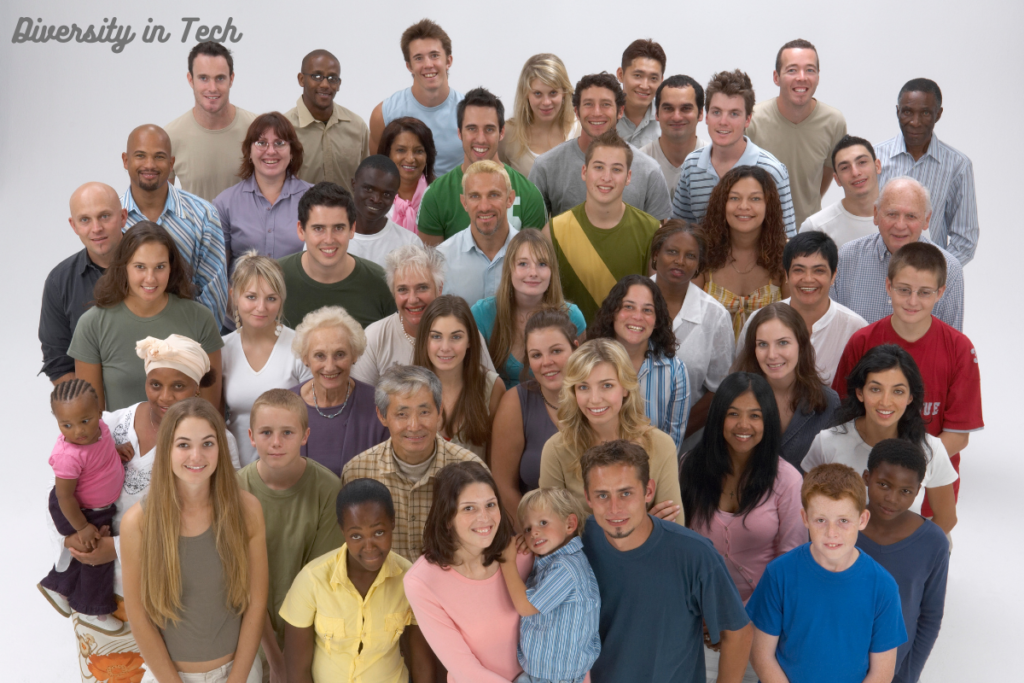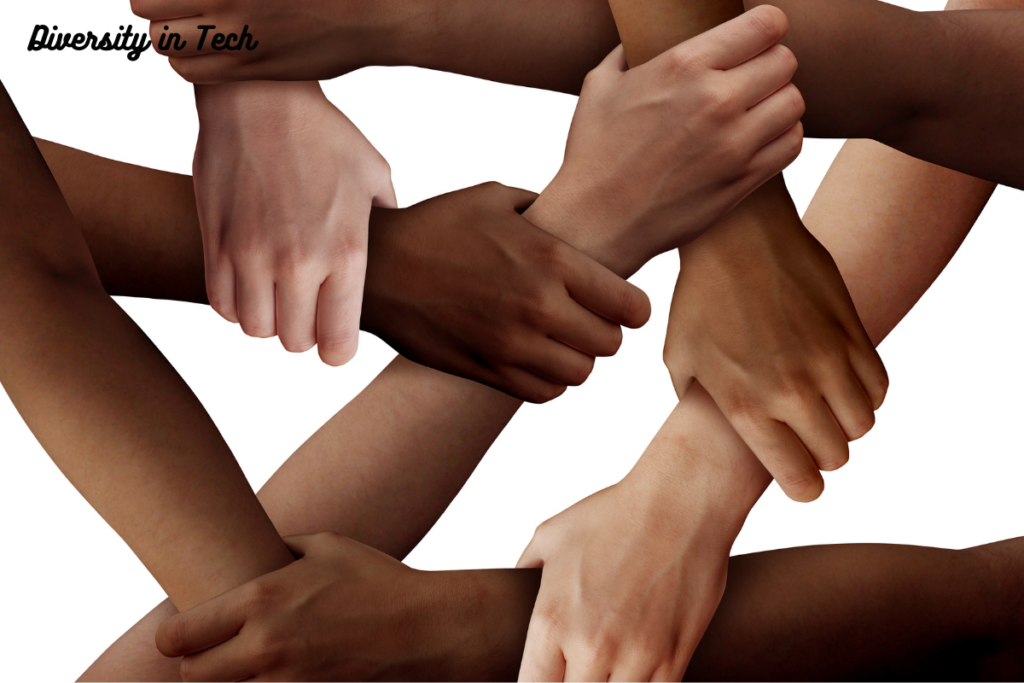Introduction: Diversity in Tech: Bridging the Gap & Creating Opportunities for All

Demographics including gender, color, age, and background are represented in “Diversity in Tech” in the tech industry. Breaking barriers and giving diverse people chances in the tech sector is crucial to establishing a more inclusive and fair workplace.
Addressing IT industry representation and opportunity disparities is key to closing the gap. Mentorship programs, diversity training, underrepresented group recruiting, and a culture that embraces and celebrates diversity can achieve this.
Everyone should have access to education, tools, and assistance to pursue a career in tech. A more diverse and inclusive IT workforce allows firms to tap into more views, ideas, and talent, boosting innovation and success.
Table of Contents
“Diversity in Tech” and its influence:
“Diversity in Tech” is a crucial and emerging topic that addresses the demand for more diverse technology professionals. This topic discusses IT industry acceptance of gender, race, ethnicity, age, sexual orientation, and other variations.
Tech companies prioritize diversity to foster an environment that values and benefits from varied ideas and experiences. This encourages equity, fairness, creativity, innovation, and better team and company problem-solving.
To improve “diversity in tech”: establish inclusive recruiting processes, provide equal career advancement and professional development opportunities, give diversity and inclusion training, and create a culture that values diversity. Diversity in tech is about fostering a more inclusive and welcoming tech community that benefits everyone.
Importance of Diversity in Tech:
“Diversity in Tech” isn’t simply a buzzword—it can change the industry for the better. Tech firms may boost creativity, create more inclusive workplaces, and better serve customers by embracing diversity.
Here are three reasons tech diversity important.
Enhances innovation and creativity by bringing together a variety of perspectives:
A tech company that promotes diversity gains new viewpoints and experiences.
Different life experiences shape thinking and problem-solving. Team members from different demographic and professional backgrounds are more likely to approach challenges differently and offer more solutions. This idea exchange can inspire new products and services.
Ideas clashing and blending in new ways foster creativity. Diversity fosters clash and mix, leading to new solutions that might not occur in a homogenous group. Google and Apple have long understood the value of diversity in creative performance.
A diverse team is less inclined to accept the existing quo. New viewpoints can challenge preconceptions and force a corporation to rethink and restructure strategies, resulting in market-pushing products.
Fosters a more inclusive and welcoming work environment:

Every employee feels valued, respected, and empowered in an inclusive workplace. Diversity helps create such ecosystems.
Diversity-focused companies are more likely to adopt anti-discrimination measures. It leveled the playing field so everyone could grow and succeed.
When employees perceive their organization values diversity and inclusion, morale rises. An organization that embraces diversity makes employees proud. Pride and belonging can boost job satisfaction and reduce turnover.
Diverse teams collaborate well because members recognize and use each other’s differences. Teamwork and organizational cohesion improve with this dynamic
Reflects the diverse user base and customer needs in product development:
“Diversity in Tech” requires goods and services for a diverse user base.
A diversified workforce can reveal client segment preferences. A tech product built with input from women, people of color, and persons with disabilities may be more accessible and user-friendly.
Product features are more inclusive when varied views are used in development. This can result in equitable and usable ICT solutions for underrepresented and underserved groups.
Diverse client bases help companies anticipate and meet market demands. These organizations acquire a competitive edge, customer loyalty, and market reach by knowing and meeting the demands of a large population.
Barriers to Diversity in Tech:
The tech business has great potential for growth and innovation, but diversity is often lacking. A welcoming atmosphere where everyone can thrive requires understanding and resolving these challenges.
Here are three major “Diversity in Tech” obstacles and their effects.
Gender and racial biases in hiring and promotion processes:

Gender and racial prejudices in recruiting and promotion hinder tech diversity. This bias manifests in numerous ways.
Although firms try, prejudices can slip into the hiring process. Resumes with male or white names may get more callbacks than those with female or minority names. Unconscious prejudice can lead to homogeneous teams and limited diversity.
Diverse hires typically struggle to advance their careers. Women and minorities are promoted less than white men, according to studies. The “glass ceiling,” which hinders upward mobility for marginalized groups, and biased performance evaluations contribute to this.
These biases affect those directly affected and send a message to potential candidates about the company’s inclusivity. Talented people may choose more inclusive sectors or firms.
Lack of access to quality education and resources for underrepresented groups:
Quality education is essential for IT success. Underrepresented communities often confront tremendous obstacles.
Many minorities and low-income people lack access to high-quality STEM education. This inequality generally starts in K-12 and continues into college education, limiting tech employment options.
Lack of mentorship, internships, and professional networks inhibits minority groups’ tech industry success beyond college. These tools are essential for career networking and practical experience.
Lack of knowledge and resources affects individuals and worsens the tech skill gap. Without diversified talent, the industry misses out on innovators and problem-solvers.
Unconscious bias and discrimination within the industry:
Even diverse tech workers face unconscious bias and discrimination that can hinder their professional advancement and sense of belonging.
Stereotypes and microaggressions from unconscious biases can make work uncomfortable. Men in tech may be seen as more capable than women, and their technical talents may be questioned. Tokenism or undervaluation can also affect racial minorities.
Informal networks and “buddy systems” can enhance careers. Underrepresented groups are generally excluded from these networks, missing out on mentorship and job prospects.
Employees with unconscious bias and discrimination may experience increased stress and worse job satisfaction. This lowers productivity and well-being and promotes turnover, which hinders company diversity efforts.
Strategies for Promoting Diversity in Tech:
Reaching “Diversity in Tech” is a strategic imperative. Tech companies may boost innovation, employee satisfaction, and worldwide market share by supporting diversity.
Here are ways to promote diversity in tech for equality and inclusion.
Implementing Inclusive Recruitment Practices and Setting Diversity Goals:
Recruitment creates a varied workforce and help in reducing the Employment Gap. To achieve this, firms must hire inclusively and set reasonable diversity goals.
Job descriptions that employ inclusive language and emphasize the company’s diversity can attract more candidates. Avoiding gendered language and emphasizing talents over experiences can help diverse individuals apply.
Diverse hiring panels reduce unconscious bias and ensure balanced candidate evaluations. Interview panels with diverse backgrounds can offer fresh insights, making recruiting decisions fairer.
Clear, data-driven diversity goals increase responsibility. To discover gaps and monitor progress, companies can track candidate, hire, and promotion demographics. Making diversity and Inclusive goals public sends a powerful message to candidates about the company’s inclusion.
Working with coding bootcamps, universities, and professional associations that serve minority tech groups helps diversify your candidate pool. Outreach activities that encourage girls, minorities, and other underrepresented groups to study STEM can boost diversity efforts.
Providing Training on Unconscious Bias and Cultural Sensitivity :
Unconscious bias and cultural insensitivity can hinder tech diversity. Training can address these difficulties and create a more inclusive workplace.
Regular unconscious bias training can help employees identify and overcome their biases. Such training can address decision-making, communication, and team dynamics to prevent unconscious biases from affecting recruiting, promotions, and daily encounters.
Employees learn to accept diverse cultural customs through cultural sensitivity training. This can increase teamwork, communication, and workplace harmony. Cultural customs, communication methods, and global inclusion may be discussed.
Incorporate diversity and inclusion training into the company’s culture rather than just once. An inclusive workplace can be maintained by fostering self-education and ongoing learning.
Creating Mentorship and Support Programs for Underrepresented Groups :
Underrepresented groups in tech need mentorship and support to grow and stay. Programs offer instruction, career networking, and emotional support.
Mentors who provide career guidance, comments, and support can assist minority employees overcome obstacles and progress their careers. Mentors should receive training to provide significant support in effective mentorship programs.
ERGs, or affinity groups, are employee-led groups that assist, network, and advocate for underrepresented personnel. These groups can help employees feel included and give underrepresented voices a voice.
Sponsorship extends beyond mentorship by senior leaders actively promoting underrepresented professionals. Sponsors can help protégés obtain prominence, access high-stakes projects, and advance their careers.
Workshops, certifications, and conferences can assist underrepresented personnel gain skills and enhance their careers. Additionally, mental health assistance and work-life balance programs might improve their well-being and retention.
Benefits of Diversity in Tech:

“Diversity in Tech” is about corporate success and a vibrant, innovative workplace, not only fairness and inclusivity. Diverse teams improve decision-making and market competitiveness.
Here are some IT industry diversity benefits.
Improved Decision-Making and Problem-Solving Through Diverse Perspective:
Decision-making and problem-solving skills are greatly improved by “Diversity in Tech”.
Diverse teams are more likely to consider more choices and opinions. Diverse perspectives reduce groupthink and provide creative solutions to challenging challenges.
Companies may foster innovation by bringing together diverse thinkers. Diverse teams can find opportunities and solve problems that a homogenous group may miss, creating cutting-edge goods and services.
Diversity helps teams analyze risk and make decisions that consider more elements. This holistic approach leads to better corporate outcomes by promoting educated and well-rounded decision-making.
Increased Employee Engagement and Retention :
Diverse and inclusive workplaces make employees feel appreciated and supported, increasing engagement and retention.
Organizations that recognize and reflect employees’ identities and experiences foster a sense of belonging. This emotional connection increases morale and motivates workers to perform well.
Diversity-friendly workplaces offer higher job satisfaction. Respect and recognition excite and engage people, increasing productivity.
Companies that embrace diversity and inclusion have lower turnover. Where employees feel appreciated and supported, they are less likely to leave, saving the company money on hiring and training new workers.
Enhanced Company Reputation and Competitiveness in the Market :
Diversity boosts internal processes and market position.
Companies that value diversity and inclusiveness are usually well-liked. This reputation can recruit great talent from all backgrounds and build customer loyalty among ethical and socially responsible consumers.
Diverse workers can better understand and serve diverse customers. Companies may improve customer happiness and loyalty by using diverse perspectives and cultural insights to produce products and services that appeal to more people.
Companies with diverse staff are more adaptable and innovative in a globalized economy. Companies with this adaptability and inventiveness can quickly respond to market changes and new opportunities, giving them a competitive edge.
Challenges in Achieving Diversity in Tech:
The benefits of “Diversity in Tech” are evident, yet establishing actual diversity and inclusion is difficult. Companies trying to be more fair and inclusive confront many challenges. Three major tech diversity challenges and their effects.
Overcoming prejudices and biases:
Overcoming ingrained biases and stereotypes:
Overcoming industry biases and misconceptions is one of the biggest hurdles to IT diversity.
Unconscious biases—deep-seated beliefs that bend our perception and behavior—can affect hiring, promotions, and daily interactions. These biases can unwittingly overlook varied brilliance by favoring “traditionally” suited individuals.
Discrimination might stem from stereotypes about specific populations’ abilities or tech positions. The belief that women are less skilled in technical professions or that certain racial groups lack skills can hamper fair talent appraisal. This helps in Empowering Women .
Due to homogenization, tech landscapes often persist. The loop of hiring and promoting people like themselves excludes minority groups.
Nurturing a Culture of Inclusivity and Belonging:
A diverse staff is just the beginning; creating a culture where everyone feels included and valued is the real challenge.
Inclusive culture respects and values all employees, regardless of background. This requires encouraging varied ideas and group participation.
Microaggressions—unintentional, subtle discrimination—must be addressed in inclusive cultures. These can greatly affect self-esteem and belonging. Companies must educate and confront such behaviors proactively.
Company places must be comfortable for employees to communicate their struggles without repercussions. ERGs and open forums can host these crucial discussions.
Sustaining Long-Term Commitment to Diversity Initiatives:
Diversity and inclusion demand constant effort. These programs can be hard to sustain.
Diversity programs sometimes stall after implementation. These efforts need leadership commitment and diversity goal reinforcement to succeed.
The definition of diversity and inclusion changes frequently. Company strategy must be flexible in reaction to new insights and social norms. This requires regular diversity metrics evaluation and employee input.
Effective diversity initiatives involve time, money, and people. To succeed, companies must invest in training, recruitment, and support.
Future Outlook for Diversity in Tech:
Technology evolves, so does the need for “Diversity in Tech”. The future looks bright for an inclusive and inventive sector as representation, intersectionality, and global demographics are promoted.
What’s next for tech diversity.
Continued Efforts to Increase Representation of Underrepresented Groups :
Despite some advances, IT industry representation is still lacking. The future will witness increasingly complex initiatives to alleviate these discrepancies.
To acquire diverse talent, companies will refine and expand their recruitment efforts. This may involve educational partnerships, minority group coding bootcamps, and community engagement.
Scholarships and grants for minority STEM students can help close the gap. These programs can help underprivileged people into tech.
Visionary leaders from varied origins will inspire future generations. Companies will promote diverse candidates to leadership roles to inspire and guide others.
Embracing Intersectionality to Address Multiple Aspects of Diversity:
Diversity efforts will emphasize intersectionality—the idea that identity intersects and affects people’s lives.
Since people can suffer numerous forms of prejudice, future diversity initiatives will be more holistic. Companies will ensure their strategies include their employees’ complicated and varied experiences.
ERGs will become more intersectional. Women, LGBTQ+, racial and ethnic minorities, disabled, and other oppressed groups will collaborate to address workplace intersectionality.
Organizations will design support systems to the unique challenges of people with multiple marginalized identities. Mentorship, leadership, and intersectional mental health resources are examples.
Creating a Tech Industry That Is Truly Reflective of the Global Population:
The ultimate goal of IT diversity is to reflect global diversity. This can be done.
Tech businesses will create diversity programs that mirror local demographics as they expand abroad. This requires tailoring diversity policies to regional cultural contexts and resolving local imbalances.
Companies will increasingly embrace inclusive design concepts to meet global user needs. To make tech solutions accessible and valuable to all, different teams will collaborate on product development.
Globalization requires cross-cultural cooperation. International connections and an inclusive global workforce that uses multiple cultural views will boost innovation and market relevance.
Conclusion:
“Diversity in Tech” is a key to technology sector innovation, equality, and prosperity. Diversity implies recognizing the viewpoints, backgrounds, and experiences of people from all backgrounds.
Tech firms can build a more inclusive and vibrant workplace where everyone feels appreciated, respected, and empowered to do their best by supporting diversity. This improves decision-making and problem-solving and promotes creativity and teamwork, which advances organizations.
Diversity will become increasingly important as tech evolves. Companies must prioritize diversity and inclusion as a moral necessity and a strategic advantage. Tech firms can promote meaningful change, build better teams, and create a more egalitarian and innovative future by embracing diversity in all its manifestations.
With continuing attempts to expand representation, embrace intersectionality, and develop a global sector, “Diversity in Tech” has a bright future. By concentrating on these areas, tech will become more inclusive, equitable, and inventive. This shift is crucial for company growth and global talent pool exploitation. Diversity will ensure a dynamic, creative, and inclusive tech industry in the future.
People also ask:
Diverse perspectives, innovation, problem-solving, inclusive products, and team performance are essential for the future of technology, ensuring success and sustainability in a rapidly changing tech landscape.
Diversity is important for the future of engineering because it allows for a lot of different points of view, ideas, and solutions. This encourages new ways of doing things, imagination, and acceptance in the field, which leads to better results and progress in all engineering areas.
Pingback: The Future of Work is Inclusive: Top Talent & D&I Strategies
Pingback: Diversity And Inclusion From Buzzword to Business Imperative
Your point of view caught my eye and was very interesting. Thanks. I have a question for you.